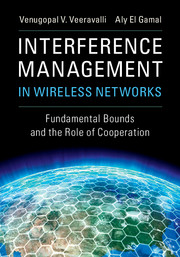Book contents
- Frontmatter
- Contents
- Preface
- Acknowledgments
- 1 Introduction to Interference Management
- 2 System Model and Sum Capacity Characterization
- 3 Degrees of Freedom and Interference Alignment
- 4 Iterative Algorithms for Interference Management
- 5 Degrees of Freedom with Coordinated Multi-Point Transmission
- 6 Locally Connected Channels with CoMP
- 7 Backhaul Load Constraint
- 8 Cellular Uplink
- 9 Dynamic Interference Management
- 10 Recent Advances and Open Problems
- Appendix A Information Theory
- Appendix B Algebraic Geometry
- References
- Index
7 - Backhaul Load Constraint
Published online by Cambridge University Press: 09 February 2018
- Frontmatter
- Contents
- Preface
- Acknowledgments
- 1 Introduction to Interference Management
- 2 System Model and Sum Capacity Characterization
- 3 Degrees of Freedom and Interference Alignment
- 4 Iterative Algorithms for Interference Management
- 5 Degrees of Freedom with Coordinated Multi-Point Transmission
- 6 Locally Connected Channels with CoMP
- 7 Backhaul Load Constraint
- 8 Cellular Uplink
- 9 Dynamic Interference Management
- 10 Recent Advances and Open Problems
- Appendix A Information Theory
- Appendix B Algebraic Geometry
- References
- Index
Summary
In the previous two chapters, we have considered cooperative transmission schemes that are constrained by the number of transmitters to which each message can be assigned. While meeting a backhaul capacity limit by a per-message constraint can have its analytical advantages, such as reducing a difficult information-theoretic problem to a simple combinatorial one, this approach suffers from a few important drawbacks.
For one, the maximum transmit set size constraint may not reflect most practical scenarios for two reasons. First, because fractional reuse across different resource (e.g., frequency or time) slots can be used to achieve an equal load on the backhaul per message, it may not make sense to impose a maximum transmit set size constraint for each channel use. Secondly, the maximum transmit set size constraint may not reflect the nature of the backhaul link, as we will discuss further below.
Also, as we have discussed in the previous chapter, the optimal solutions for the maximum transmit set size constraint may not fully utilize the constraint; i.e., for the optimal solution, some messages need not be assigned to the allowed maximum number of transmitters. We have seen in Chapter 6 that this is the case for the optimal schemes for linear interference networks, as well as for general locally connected networks where we impose the restriction of using only zero-forcing coding schemes.
The appropriate constraint to consider for the assignment of messages to transmitters should depend on the nature of the backhaul link used in practice (see, e.g., [69, 86]). For example, in the context of heterogeneous networks, the backhaul can be a wireless network, and an overall backhaul load constraint would be a more appropriate choice. On the other hand, for the case of wireline or optical fiber backhaul links, the maximum transmit set size constraint can be useful. However, even with wireline backhaul links, an average transmit set size constraint can allow for flexible solutions that interleave the use of the backhaul links over multiple communication sessions. In general, a constraint that bounds the average transmit set size is more relevant to practice than imposing a maximum constraint on each transmit set size. We show in this chapter how the solutions for the CoMP transmission problem provided under the maximum transmit set size constraint can be used to find solutions under an average transmit set size or backhaul load constraint.
- Type
- Chapter
- Information
- Interference Management in Wireless NetworksFundamental Bounds and the Role of Cooperation, pp. 126 - 147Publisher: Cambridge University PressPrint publication year: 2018



